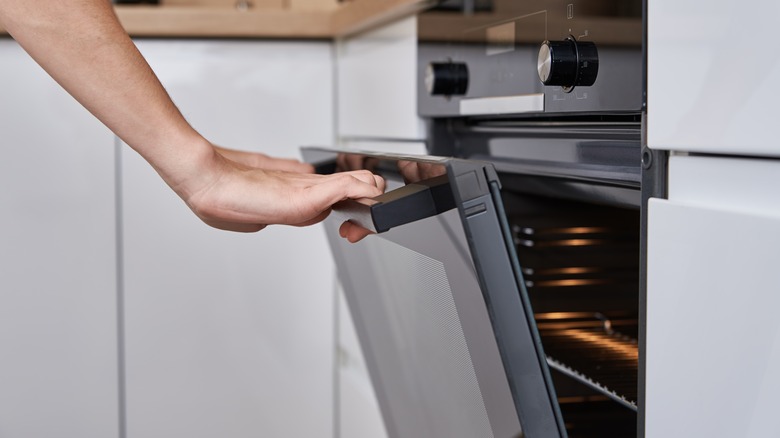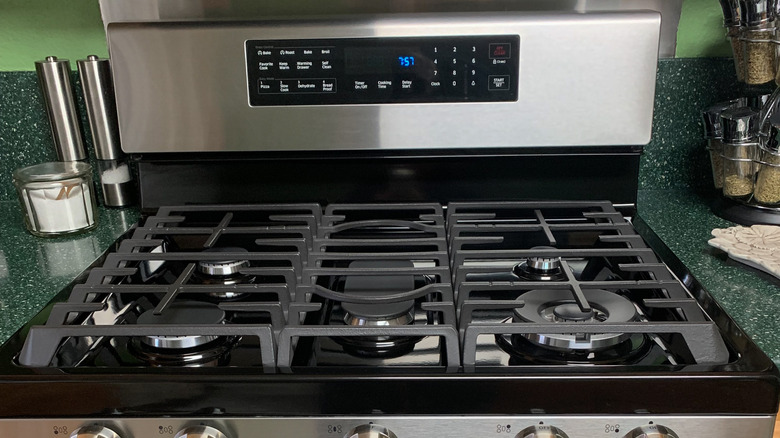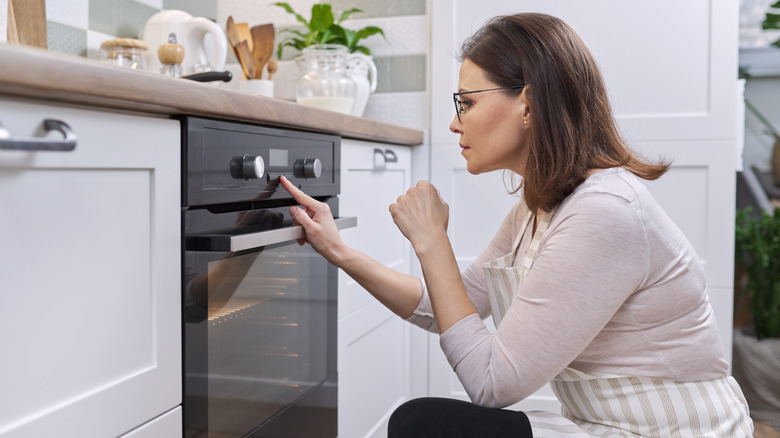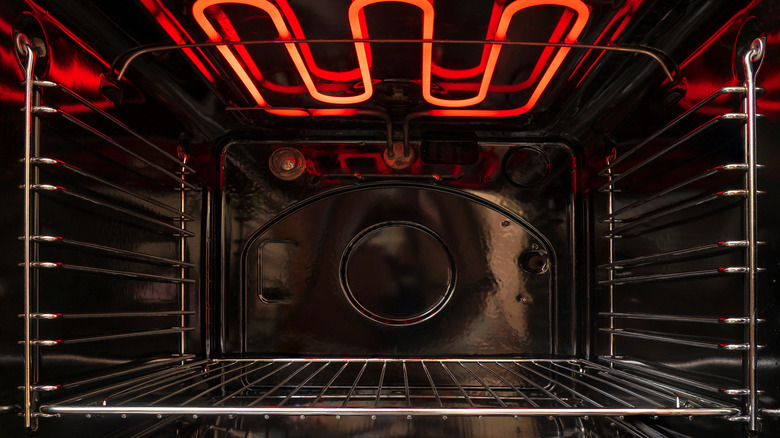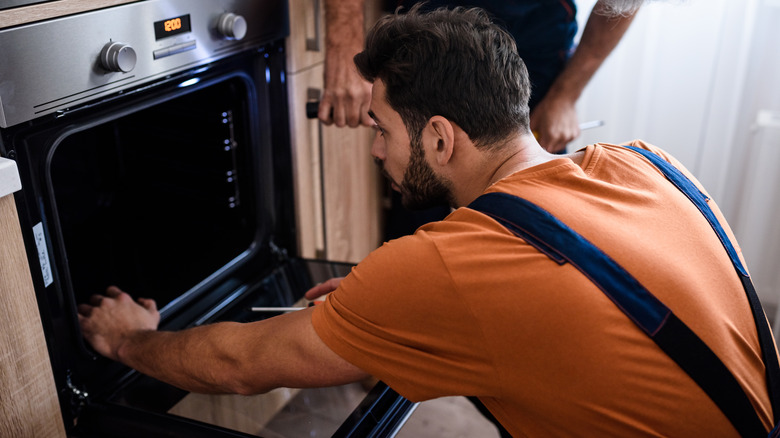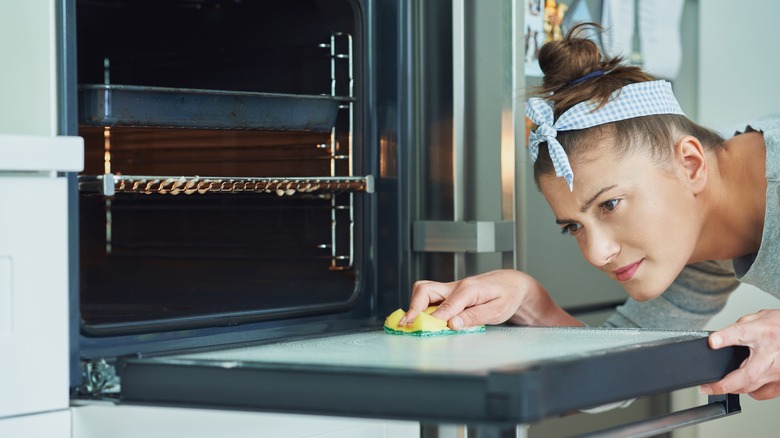Precautions You Should Be Taking When Self-Cleaning Your Oven
Gaining motivation to clean throughout the week can be hard to muster. Many of us are guilty of intending to deep clean every week and never actually getting around to it the way we want. And even on days when we find the energy and clean like our lives depend on it, there are still areas that typically get overlooked. Daniel Scott Kitchens found that the oven is the second least cleaned appliance in the home, estimated only to be cleaned around twice a year. Ranges are also tricky to clean as they have a lot of different components, such as the base, trays, filters, and fans, that collect bacteria with each use.
Due to the appliance being time-consuming and difficult to clean, the self-cleaning option on most ovens is very convenient. It requires much less down-and-dirty cleaning and is often compared to a dishwasher in the sense that you simply wait for the machine to do its thing and then clean up the aftermath. Consumer Reports found in a 2020 survey that self-cleaning ovens are the most sought-after feature in a range, as told by more than 40,000 respondents. It may be easier to have your oven self-clean, but there are many precautions you should be taking when using this feature.
How does an oven's self-cleaning work?
When you decide it's time to self-clean your oven and press that small button that sets it into motion, Whirlpool explains that the oven will enter into pyrolytic cleaning by heating to 800 degrees Fahrenheit or hotter, incinerating any food particles crusted on the inside. Once the cleaning cycle is complete, which can last between one and three hours, the only thing left to do will be to wipe away the leftover ash.
If you have a steam-cleaning oven, the process is a bit different. Rather than heating to the temperature of 800 degrees Fahrenheit or higher, a steam cleaning oven won't get much hotter than 400 degrees Fahrenheit. The range won't automatically lock the way it does during a pyrolytic cycle, and it only softens the particles, leaving you to wipe it all away after it has completed its cleaning. These self-clean features sound pretty straightforward, but prepping your oven correctly and taking precautions are necessary for successful cleaning.
Prepping your oven
Regardless of what type of self-cleaning your oven offers, it is crucial to prep it properly beforehand. How Stuff Works recommends removing everything from your range, such as dishes, floating debris, and racks. The oven's racks should be cleaned by hand if they are not enamel; otherwise, they will severely rust over time. Forgetting to remove the shelves here and there won't be detrimental; however, it shouldn't be a habit.
With how hot your oven is about to become, it would be beneficial to uncover the oven vent and turn on the exhaust fan to help clear away any smoke and fumes that arise during the cleaning process. Opening up some windows will significantly help air ventilation as well. Most ovens that feature pyrolytic cleaning will automatically lock the door, but it is still beneficial to double-check that the door is secured. Before starting the self-cleaning cycle, you should keep in mind that this can last up to three hours and that you should be home the entire time. Leaving the oven completely unattended when it reaches extreme temperatures is dangerous all around.
Be cautious of high temperatures
Immediate third-degree burns can occur when your skin comes in contact with anything between 130 to 150 degrees Fahrenheit. When your oven self-cleans, it reaches nearly six times those temperatures. It is essential to understand the danger of heating your oven to these conditions and how to navigate it safely. P.C. Richard & Son suggests that the amount of times you self-clean your range doesn't exceed once every six months due to how hot it needs to be to perform the cleaning. Even your oven can have a hard time handling those high temps, and using the feature more than necessary can result in the appliance needing maintenance repairs.
Keeping children and pets out of the kitchen during the clean may also be wise, as the oven will be very hot and release smoke and fumes that could contain carbon monoxide. Cleaning any excessive debris before running the cycle will eliminate the possibility of larger flames. If you notice any flames escaping the oven doors, immediately stop the cleaning cycle. Lastly, be sure your oven has completely cooled down before attempting to clean the ash residue or placing the racks back in.
Consider how old your oven is
If you want to run a self-cleaning cycle on your oven, you should know exactly how old it is. A range is considered old if it is anywhere between 8 and 10 years after the manufacturing date. Still, there are also clear signs to look for when contemplating whether self-cleaning is optimal for your oven. Older ovens can be riskier to attempt this with as they have a more challenging time insulating the heat. So, drastic temperatures over 800 degrees Fahrenheit can be way too much for the appliance to handle, resulting in broken fuses and other issues.
Appliance Express states that one of the top identifiers that your oven may be reaching the end of the line is the escaping of heat. If your oven is not containing heat properly or is scorching surfaces in close proximity, then it is certainly not a good idea to let it self-clean. Suppose you notice uneven cooking or the racks are no longer fitting correctly. This is due to the oven's inner chamber bowing out of shape and is another sign that the appliance has difficulty handling high temperatures.
Taking all pros and cons into account
Keep all provisions in mind when it comes time to clean your oven. Since it is only recommended to self-clean once every six months but to clean the oven once every three months, you will have experience with both automatic and hand cleaning, which will help you choose the most comfortable option for yourself. The self-cleaning feature on ovens is popular for a reason, which is due to the convenience and energy efficiency it offers. Fix Appliances explains that self-cleaning ovens are manufactured with heavier insulation that won't waste extra energy by leaking heat. But even with all the pros you can think of, always consider if they offset the risks and if you are prepared to handle those risks.
Many consumers report issues with their ovens after self-clean cycles, such as damage to the thermostat and control panels from such high heat. However, if you choose to clean your oven this week, pick the option best suited for your circumstance and be sure you understand the complexities of your oven's self-cleaning feature.
